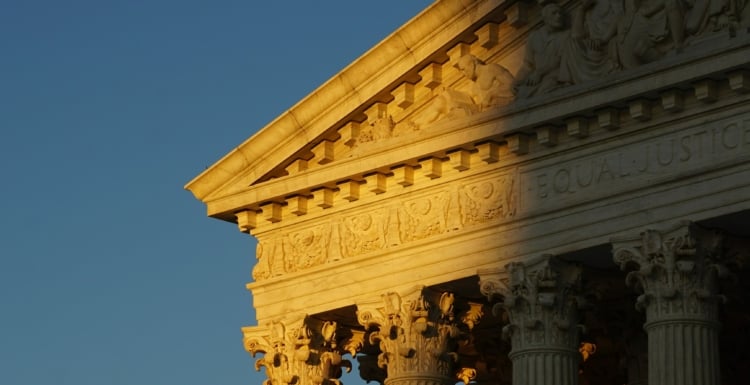
After the Bruen decision, the 5th Circuit reversed its decision, according to a petition filed by the Department of Justice (DOJ). …
The court ruled that Mr. Rahimi had been deprived of his Second Amendment rights.
Define ‘Dangerous’
DOJ lawyers told the court that the 5th Circuit had misread the Bruen decision.
At that time, Republican-appointed Chief Justice John Roberts asked Mr. Rahimi’s lawyer, J. Matthew Wright, “You don’t have any doubt that your client is a dangerous person, do you?”
When Mr. Wright said it depends on what was meant by ‘dangerous person,’ the chief justice responded with, “Well, it means someone who’s shooting, you know, at people. That’s a good start,” according to The Associated Press.
However, Justice Samuel Alito, a Bush appointee, expressed concern that someone could receive a domestic violence restraining order without “any finding of dangerousness” before losing their Second Amendment rights. …
Mr. Grieve pointed out that under Bruen’s text requirement, the justices will need to determine the definition of “the people.”
“What are the limits of the phrase ‘the right of the people?’ Is it just law-abiding citizens? Is it everyone?” he said.
The justices will also have to determine what constitutes “tradition.” How far back do they have to trace a law’s lineage before it can be considered a tradition?
Conflicting Ideas on Tradition
According to Mr. Grieve, many gun control advocates point out that the Second Amendment was incorporated into the states under the Constitution’s 14th Amendment, which guarantees equal protection under the law.
But most gun rights activists say tradition requires the court to consider the law in the context of the year that the Constitution was ratified, 1791. At that time, there were far fewer gun regulations.
“There is seemingly no end to the directions this could be going,” Mr. Grieve said.
And while it’s not as significant in the Rahimi case, some gun rights advocates expect due process to be a factor. …
Gun rights advocates say Rahimi is the most consequential Second Amendment case before the court.
“This is going to set the battlefield for a lot of other legal decisions. It’s going to be very important to see how they do it,” Mr. Grieve said.
Federal Overreach
Rahimi isn’t the only major case at the Supreme Court—two other high-profile Second Amendment cases involve more legal questions than just gun laws.
Cargill v. Garland is more than just a case about the legality of using a bump stock, an accessory to increase a shooter’s rate of fire. The real question is how much authority government agencies are allowed to exert. …
The Cargill case came about in the wake of the 2017 Las Vegas shooting in which a killer used rifles outfitted with bump stocks to fire at concertgoers in Las Vegas, killing 58 and injuring hundreds in about 10 minutes.
Then-President Donald Trump requested the Bureau of Alcohol, Tobacco, Firearms and Explosives (ATF) to consider whether the devices could be reclassified as illegal machine guns.
In 2018, seemingly at President Trump’s behest, the ATF reversed years of written opinions—some issued in response to inquiries from members of Congress— and reclassified bump stocks as machine gun parts regulated under the National Firearms Act of 1934. …
From 2010 to December 2018, the ATF held that bump stocks don’t convert rifles into machine guns and, therefore, aren’t subject to the very strict legal requirements that machine guns fall under.
Even gun control advocates decried the ATF’s 2018 reclassification as unconstitutional. …
In 2019, Texas resident Michael Cargill sued, claiming that the ban is an unconstitutional usurpation of Congress’s legislative powers by the DOJ and the ATF at the direction of President Trump.
Mr. Cargill’s claims eventually found their way to the 5th Circuit Court of Appeals, which ruled in his favor.
The ruling from the 5th Circuit states: “Cargill is correct. A plain reading of the statutory language, paired with close consideration of the mechanics of a semi-automatic firearm, reveals that a bump stock is excluded from the technical definition of ‘machine gun’ set forth in the Gun Control Act and National Firearms Act.”
The DOJ appealed that decision to the Supreme Court. …
While Cargill is, at its core, a Second Amendment case, Mr. Grieve said that, as with Rahimi, there’s a bigger question.
“Do we want the ATF to be the judge, jury, and executioner?” he asked.
Regulatory Authority
Another case that gun rights advocates are watching involves firearms but isn’t a Second Amendment case.
Civil libertarians, business groups, and Second Amendment supporters say the National Rifle Association (NRA) v. Maria T. Vullo could be a landmark First Amendment case. …
Ms. Vullo was the superintendent of the New York State Department of Financial Services (DFS), the regulatory agency overseeing financial institutions for the state of New York.
The case has even drawn the American Civil Liberties Union (ACLU), typically on the opposite side of the fence from the NRA, over to the gun rights group’s defense.
“Substitute Planned Parenthood or the Communist Party for the NRA, and the point is clear. … The First Amendment bars state officials from using their regulatory power to penalize groups merely because they promote disapproved ideas,” the statement reads. …
How do you think the Supreme Court will rule on gun rights? Share this article to raise awareness of these crucial cases.
(Excerpt from The Epoch Times. Photo Credit: Ian Hutchinson on Unsplash)

